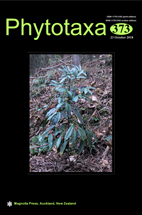Abstract
Six Eugenia species from the Atlantic Forest of Alagoas state, northeastern Brazil, are described here: Eugenia anthropophaga, E. cambemba, E. curuba, E. jussara, E. mammifera, and E. palmarina. Eugenia anthropophaga and E. jussara are morphologically similar to each other but distinguished by the ovate (vs. linear in E. jussara) bracts, fruiting pedicels not swollen (vs. swollen) at the base, and subglobose (vs. pyriform), pilose (vs. glabrescent) and deeply 8-costate (vs. slightly 8-costate) fruits with patent (vs. erect) calyx lobes. Eugenia cambemba is morphologically similar to E. valsuganana but differs by the leaf blades cuspidate at the apex, and fruits longer, obovoid, and reddish when ripe. Eugenia curuba is similar to E. pruinosa, differing by the leaf blades obtuse to rounded at the apex, with 12–14 secondary veins per side, and sessile fruits with subtly glandular-rugose surface. Eugenia mammifera differs from E. coffeifolia by the elliptic leaf blades with 14–17 secondary veins, eciliate calyx lobes, and fruits 8-costate and constricted at apex. Eugenia palmarina differs from E. barrana by the widely elliptic leaf blades with minute glandular dots on the adaxial surface, with 12–15 secondary veins per side, and longer triangular or linear bracts. Due to the restricted distribution and imminent threats, the new species are provisionally considered as Critically Endangered (CR), in accordance with the IUCN criteria. Data about geographical distribution, habitat, and comments on morphological affinities are provided.

